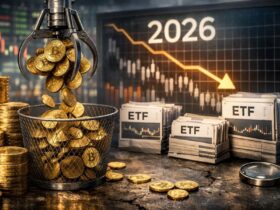Bitcoin moves away from $108,000, its all-time high price.
According to some on-chain metrics, it could be reaching ‘bear market’ levels.
He bull run Bitcoin (BTC) is not following the steps that many expected. After having surpassed $108,000 in mid-December, several traders and analysts believed that the path towards $110,000 would be without pause. But fate had some surprises in store.
At the time of this publication, far from those historical highs, bitcoin struggles not to lose $90,000 support.
The chart below shows the price of BTC over the last 3 months.

Today, January 13, bitcoin fell below $90,000 for the first time since November 18. According to specialists from The Kobeissi Letter, BTC is 3% away from entering currency territory bear market.
Something similar is shown by the company Glassnode based on on-chain analysis. As CriptoNoticias reported this morning, “the cost base model of short-term bitcoin hodlers is crucial to gauging sentiment among new investors.” This is a model that historically “has followed market lows during bull cycles and has also distinguished bull markets from bear markets.”
The aforementioned model establishes that the base cost of short-term hodlers is $88,135, as can be seen in the image below:

If the price of bitcoin falls and stabilizes below that level, according to Glassnode specialists, “it may indicate a weakening of confidence among new investors, which is usually a turning point in market trends.”
It is worth clarifying that not only BTC is in the red, but all financial markets are following similar behavior. The following image shows the price movement of the main stock stocks listed in the United States market:

The main reason for this behavior is that reports are becoming known indicating an increase in inflation of the US dollar. Also, inflation expectations in the medium term (for example, for the remainder of 2025) are rising.
And what does this have to do with financial markets? That If inflation increases, it is very likely that the Federal Reserve (Fed) will completely abandon further cuts in interest rates (or, in the worst case scenario for financial markets, increase them again).
When interest rates are high, the cost of borrowing increases and, therefore, there is low liquidity in the markets. Additionally, investors are seduced by Treasury yields.
Instead, when interest rates fall, liquidity is injected into the market and investors take risks towards more volatile assets (such as stocks, cryptocurrencies and bitcoin) in search of higher returns.
Currently, according to the analysis of The Kobeissi Letter specialists, “general uncertainty has increased throughout the market, with the increase in CPI, PPI and PCE inflation” (all of these are various metrics that express inflation in USA, main world financial power).
Waiting for January 20
On January 20 everything could change and be a financial turning point. In exactly one week, Donald Trump will assume the presidency of the United States.
What’s coming on a financial level? Will the president keep his promises? Will it revive the economy and “make America great again”?
To a large extent, the volatility these days in bitcoin, stocks, cryptocurrencies and other financial assets is due to these questions that for now are unknown.
Coinbase exchange analysts they explain that the market is focusing on the inauguration of President-elect Trump as one of the main potential catalysts for the cryptocurrency market.
It is worth clarifying that the market shows expectations that may not be met in the time that investors would like. This could trigger some “selling the news” event and cause prices to crash.
Coinbase specialists say:
“While some potential announcements, such as the confirmation of a strategic bitcoin reserve, could provide upside, Polymarket assigns relatively low probabilities of that happening in the first 100 days.”
Coinbase, bitcoin and cryptocurrency exchange.
Therefore, it is possible that bitcoin and cryptocurrencies will continue to show high volatility without a defined trend (bullish or bearish) even after Donald Trump takes office.

The long term is what matters with bitcoin
Despite the current turbulence and the shadows that seem to loom over the immediate horizon, bitcoin’s long-term trajectory remains the subject of persistent optimism.
If you look at the historical chart of the bitcoin price, you can see that the bullish trend has remained unchanged despite the high volatility.

And nothing suggests that that has changed. Is highly likely that BTC will continue to increase its price (measured in fiat money) over time.
There are several reasons that suggest that this will be the case. Despite recent fluctuations, Bitcoin adoption by financial institutions and businesses continues to rise. This trend suggests growing legitimation and confidence in bitcoin as a store of value and investment asset, which could support its price in the long term.
Added to this is the fact that the BTC supply model, with its 21 million hard cap and halving events that reduce miners’ rewards, creates a programmed shortage that can drive the price up as demand grows and the supply becomes more limited.
The latter is especially relevant in a world where inflation becomes a growing concern. Bitcoin is seen by many as “digital gold”an asset that can serve as a hedge against the devaluation of fiat currencies.
CriptoNoticias has reported numerous predictions for bitcoin in 2025 and most of them are bullish (and we are not talking about 2030, or 2040, but for this same year).
Michael Saylor, president of MicroStrategy, believes that bitcoin will reach $180,000 in 2025. He also predicts that the price will then fall towards the $140,000 area and when that happens, people will go crazy.
In line with its predictions, MicroStrategy (which is the publicly traded company with the largest amount of BTC accumulated) today announced a new purchase of bitcoin. This company already accumulates 450,000 BTC in its treasury!

Bernstein, an investment and analytics firm, is more optimistic than Saylor. The specialists of this company assure that bitcoin will reach $200,000 during the current year.
The Argentine Iván Paz Chain, more moderate, explains that his goal for bitcoin in 2025 is $140,000. In any case, he clarifies that this could change depending on market movements.
Bitcoin is definitely not a fad
Since its creation, Bitcoin has gone from being a marginal project, born in the discussion forums of cypherpunks and libertarians, to position itself among the ten largest financial assets in the world.
This transformation is evidence of how technology and human creativity can radically alter the pre-established norms of the global financial game.

The history of bitcoin isin many ways, the chronicle of a constant challenge to traditional economic systems and a redefinition of what we understand by money.
This digital asset has proven to be much more than just a speculative tool; It has become a benchmark of resistance against centralized control and an inspiration for millions seeking alternatives to the predominant financial structures.
Over the years, we have seen institutions that once dismissed bitcoin as a fad now find themselves investing in it, building financial products around it, and recognizing its intrinsic value as “digital gold.”
Such a change in attitude is testament to the indomitable spirit of bitcoin, which persists and expands despite market cycles and price fluctuations.
Furthermore, the current global context of economic and financial uncertainty has demonstrated the relevance of having decentralized and censorship-resistant alternatives.
In this scenario, it is reasonable to maintain a mostly bullish outlook on bitcoin. Not only because metrics and historical patterns suggest a path of growth, but because the foundation of its creation remains an ideal towards which many in the world aspire.
This is a journey of continuous transformation and bitcoin still has many pages to write, many economies to influence and many paradigms to change.
So, as we prepare for what the future may bring, one thing seems certain: bitcoin will continue to be a key player in the narrative of global economic and technological development (and its price will likely accompany such growth).






Leave a Reply